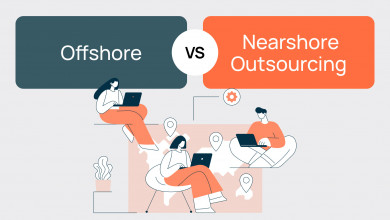We had the pleasure of talking to Tony Belkin, the Vice President of Digital Platforms at CAT. We really appreciate Tony taking the time to discuss the hot topic of IT outsourcing, on which we get tons of pressing questions daily.
With over six years of experience at Caterpillar, Tony brings a wealth of knowledge and perspective on how companies can effectively manage and optimize their IT outsourcing strategies on a global scale. This interview sheds light on the big picture of outsourcing to Europe and beyond, in the past and in today’s conditions.
Let’s see what valuable takeaways and insights we got from this exciting conversation. Here’s the interview in its raw form!
The interview was conducted by and with:
- Stuart — S
- Tony — T
S: Right off the bat, Tony, could you tell us about your outsourcing experience at Caterpillar?
T: Yes. When I first came to the company, there was a lot of outsourcing culture. I saw there were two problems. One was that a lot of vendors owned code for years, for dozens of years, and anytime we made something [some change to the code], it cost us an arm and a leg.
The second problem was that each application was developed as a full-stack. So, every other application team had to go acquire data, cleanse it where needed, and then build services, build a consumption layer, and build the application. Our senior managers would then pass the software on to vendors and stakeholders for approval, getting unpredictably changed software back.
Disparate teams gave me conflicting data. We wanted to fix it. So we built a data and services platform and migrated lots of applications to it. As a result, we've saved a lot of money, shut down a lot of unnecessary applications, improved quality, and boosted scalability. It was good. So that was what I was responsible for.
S: So, the first real question of this interview — what is your attitude regarding IT outsourcing?
T: Well, you need to break up IT first. There is IT infrastructure work, which is more of a support function, and then there is software development. I'm mostly involved with the software development, but either function can be outsourced nearshore or offshore. It just needs to be structured properly. This IT outsourcing availability situation has been a reality for the past 30 years, really.
S: In your opinion, are there some tasks or jobs that are ultimately best off outsourced rather than kept in-house?
T: I may have a more conservative view on this one. I think that all functional critical tasks must be owned by the company, whether the actual work is done completely or partially by the vendors. Let's say it depends on the area. The only parts you want to completely outsource are the ones you have no competitive competence with. Or you can just be winding down working on a lot of projects at once, running on deadlines. Those are perfect for outsourcing.
S: Okay, which countries or regions would you consider advisable to outsource IT development and support to?
T: Well, it really depends on the skills and what kind of work you need to do. We're using nearshoring in Latin America and South America. We're using nearshoring in eastern Europe, and we are also nearshoring to some extent in India, China, and other places. Again, depends where you have the skills and where you can find the right people.

S: I see. So, when it comes to determining what region is more suitable for outsourcing, it really comes down to skills and availability in those regions?
T: Yes. And the model of work. For example, you can outsource the entire chunk of a deliverable to the vendor, or you can have the vendor participate as part of your team doing co-development. If you're doing co-development while at least being in the US with a provider based in Latin America or South America or in Eastern Europe, you get time advantages — you can have pretty large time overlaps with the team.
If you cannot do that, then you're probably offloading entire functions, which are less expensive and can be outsourced to China or India. By the way, we use the same approach for our internal work, not just for outsourcing. We have teams in all those locations. That's how we decide where to distribute work.
S: Have you had any experience with outsourcing to companies that are based in destinations such as Ukraine, Poland, or Slovakia?
T: Yeah, we are using a lot of this outsourcing area now, including Romania and Eastern European countries.
S: Where does it stand from a quality perspective? Have you had any issues with those countries?
T: Well, we started outsourcing to that area back in the mid-nineties, and at the time, it was great. Then, the prices went through the roof when a lot of security software was outsourced out east, so we kind of stopped. In all our latest business rounds, we're doing it again. The pricing is good. The experience of people is really good.
You're getting, probably, half the price for somebody with maybe five to ten years more experience. So we've been very successful with that. We have a pretty large contingent.
Again, this is mostly a team extension initiative for our scrum team in the US. Out of eight people, you may have two or three employees, maybe one or two contractors in the US, and maybe three to four people working nearshore.
S: Could you describe the opportunities or challenges of working with IT vendors from Eastern Europe?
T: The biggest problem for us has been getting them laptops. Especially in some countries, it's very hard to ship to, because we have our IT organizations very worried about security.
So they want to make sure we provide secure machines and get them to the right place, to the right person, and repair them when needed. That's been probably the biggest challenge. We do have VDI or screen sharing, but it's not always effective for some development tasks.
Other than that, it's been working great.
In fact, we started a long cycle of converting some of those people, trying to get them H1-b visas or permission to work in Europe and bring them as employees because they're really good.
S: Well, that's really good to hear.
T: Actually, COVID helped us a lot, because all the teams thought they needed to be co-located. Partially because of the tools, partially because it was a perception. So, all the teams used to be local to Chicago, Peoria, and Denver, where we have locations. And now, with COVID making everybody remote, we started experimenting with the remote people nearshore.
It just worked out great, and we continued growing in that area.
S: Isn't that interesting? A sort of side benefit from something that was mostly negative.
T: Yeah, yeah, we kind of suspected it's going to be like that. Plus, tools improved, and a lot of in-team improvements were made so people could get in and out very easily and not miss a beat. That was actually a good part of that.
S: What are any nuances in working with outsourcing teams, including time zones and cultural differences?
T: Well, upfront, we require at least five to six hours of overlap per day, and it hasn't been an issue most of the time. Some people object, so, you know, they don't join us. The other part is finding the right vendor because part of the issue was to train the vendor to do better selectivity.
So we don't spend a lot of time interviewing people. It took us about maybe six months to tune the process. By now, we probably have, I want to say, a 70% acceptance rate for people we get recommended.
S: What do you usually dedicate those five to six hours a day of overlap to?
T: A lot of time is dedicated to discussing security measures and core developers’ job.
S: Do you also like to participate?
T: Not me necessarily, these meetings are mostly for people who do core development. But if we’re offshoring work, then it doesn't really matter. If they want, they have the whole piece of software, so they can do whatever they need to do.
S: Okay. Any other tips on how you effectively manage teams from different time zones and cultural backgrounds?
T: No, no, not really. It's actually been working really well. We've been doing it for a long time, and it's working great.
S: What challenges would you say companies from the US typically face when they're outsourcing development?
T: Again, outsourcing, depending on the model, is the problem. For instance, when outsourcing entire piece of work, you lose control. A lot of people think they're going to keep a technical person in-house while the outsourcing team vendor is doing the outsourcing work only.
And it works for, say, the first year, but then, if you're not developing, if you're not learning the problems, if you're not getting deep into the stuff, you get obsolete in about three to five years.
You have no idea what software you get on your hands eventually. So you need to have some good participation and good learning. Now, there's certain software that doesn't matter much, which is okay, or it's more operational software, which is kind of more like workflow management stuff. You can outsource it. We use this approach, but very judiciously.
S: If you were to talk to other US companies, what benefits would you say they could derive from outsourcing IT development?
T: Well, I took one department under me last year, and in two years of co-development in Eastern Europe, we reduced the price per head by 30% by simply growing in Eastern Europe and maybe backfilling some of the contractors.
We had a really high contractor turnover in the US, maybe two years ago, so we started backfilling them with one or two people in Eastern Europe, and our price per head went down significantly. It wasn't really a goal at the time, it was just to keep things going, but the results were really good.
S: So, price first. Anything else?
T: Price — number one. There are areas with really good talent. If you're doing core development, if you're doing embedded, if you're doing OS, if you're doing cloud — there are different places.
We have a lot of expertise in the area. But I would not, for example, go into this [outsourcing] model with people requiring hardware. You need a sizable team to justify that. We used to have a team in Eastern Europe to whom we had to ship hardware, and part of the time we had to deal with customs and other stuff.
It's been very hard to get hardware in and out. Then, you have to destroy it [once it’s out of order], so it makes things even more complicated. But right now, I'm mostly dealing with cloud computing, so there's nothing to send other than development laptops. So we're looking good.
S: Right. Okay, what advice would you offer to us companies seeking resources for software development or support?
T: Well, any company that wants to do software development has to have their own development core. They really want to be good at it and they want to be effective at it. I mean, obviously, there are vendors coming in offering turnkey solutions. But then you end up grossly overpaying for that because they are set up to make money and not to make you successful.
So for people who don't have any software backbone — you got to find trusted supplier people who have software backbone in their company. You just need to be very strategic about what you're bringing vendors in and what you own.
At Caterpillar, five or six years ago, we were heavily dependent on vendors, and while they actually owned pieces of software, people internally had little view on that software. Now, even when we outsource to the vendors, we're still involved in development code reviews, design reviews, so we're not just letting them run and look at the test results.
S: That makes sense. What tips, then, would you offer to companies seeking to successfully organize the outsourcing process to achieve the best results?
T: Hire even small internal core software teams who kind of know what they're doing and take it from there. I mean, many companies have IT departments that outsource software development. That's typically problematic. If you need to customize teams or other stuff, sure. But if you want to do some serious development, especially that which your business depends on, I would not approach it that way.
S: Any final thoughts in terms of IT outsourcing or information you'd like to provide for anybody else out there?
T: You know, the teams in different countries have different ambitions, and you need to understand them. Especially when doing some rotation. We had a lot of people in India. It's a very attractive hourly rate that you get over there, but you have to build a team and you can't just randomly grab the people.
Today, when we have to add a person to our sizable teams — over a thousand people just in my organization — it takes five or six months to get the person on board. We are heavily into college recruiting over in India, but we do have a critical mass. If you're trying to get into contracting, like temporary third-party labor in India, the talent is pretty low.
So we mostly go with the statement-of-work kind of labor because they have much better talent. But that's India. In other places, you have different intricacies, so you need to understand that space.
S: Excellent. All these questions and answers are really good information to have.And I know there's a lot of people out there that'll be interested to hear it.
T: It's been good. Glad to help!
S: We appreciate your time today, Tony.
T: Sure! Thanks, Stuart!
In closing, Tony Belkin's insights into IT outsourcing reveal the seeming complexity and strategic considerations involved in successfully managing outsourced teams all over the world.
Tony’s emphasis on maintaining a strong internal core while strategically outsourcing non-critical functions provides valuable lessons for any company considering IT outsourcing — this is a balanced that can help companies achieve both cost savings and high-quality outcomes in their IT projects.


